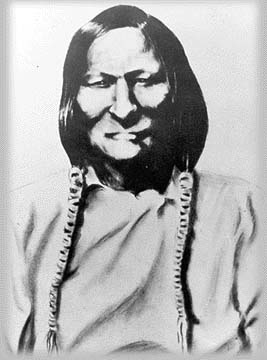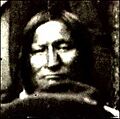Black Kettle facts for kids
Quick facts for kids
Black Kettle
|
|
|---|---|
 |
|
| Born |
Mo'ohtavetoo'o
c. 1803 |
| Died | November 27, 1868 (aged 64–65) Washita River, near present-day Cheyenne, Oklahoma
|
| Cause of death | Gunshot wound |
| Nationality | Southern Cheyenne |
| Known for | Colorado War Sand Creek massacre Treaty of Medicine Lodge Battle of Washita River † |
| Title | Tribal chief |
Black Kettle (in the Cheyenne language: Mo'ohtavetoo'o) was an important leader of the Southern Cheyenne people. He lived from about 1803 until November 27, 1868. He played a key role during the American Indian Wars.
Black Kettle was born in the Black Hills area, which is now South Dakota. He was part of the Northern Cheyenne. Later, he married into a Southern Cheyenne group that was mixed with Kiowa and Lakota Sioux people.
Many remember Black Kettle as a peacemaker. He tried to make agreements with the U.S. government to keep his people safe. Sadly, he was killed on November 27, 1868, during the Battle of Washita River. He was trying to escape with his wife when soldiers from the U.S. 7th Cavalry attacked.
Contents
Black Kettle's Early Life and Leadership
Black Kettle was born around 1803 in what is now South Dakota. We don't know much about his early life before 1854. In that year, he became a chief of the Council of Forty-four. This council was the main government for the Cheyenne tribe. They often met at Sun Dance gatherings to show their unity.
After 1851, the Cheyenne and the U.S. government had an agreement called the Treaty of Fort Laramie. However, the U.S. government did not stop white settlers from moving into the Great Plains. This was especially true after the Pike's Peak Gold Rush started in 1859.
European American settlers took over Cheyenne lands, breaking the treaty. They also used up important resources like water and game animals. This growing competition often led to fighting between the groups.
Black Kettle was a practical leader. He believed that the U.S. military was too strong and there were too many settlers to fight against. In 1861, he and the Arapaho people made a treaty with the commander of Fort Lyon. This was called the Fort Wise Treaty. Black Kettle hoped this treaty would protect his people.
However, the treaty was very unfair to the Southern Cheyenne. Black Kettle even visited Washington, D.C., where President Abraham Lincoln gave him a large American flag.
The Cheyenne moved their groups to the Sand Creek reservation. This was a small area in southeastern Colorado Territory, about 40 miles from Fort Lyon. The land was not good for farming. It was also far from buffalo, which was their main food source. Many Cheyenne warriors, including a group called the Dog Soldiers, did not accept this treaty. They started attacking white settlers. Historians still debate whether Black Kettle agreed with these attacks, allowed them, or encouraged them.
The Colorado War and Peace Efforts
By the summer of 1864, the situation was very tense. Some Southern Cheyenne warriors, along with their Kiowa and Arapaho allies, raided American settlements. They took livestock and supplies. Sometimes they also took captives, usually women and children. They would adopt these captives into their tribes to replace lost family members.
On June 11, 1864, Native Americans killed a family of settlers. This event was called the Hungate massacre. Colorado governor John Evans thought that tribal chiefs had ordered this attack. He believed they wanted a full-scale war.
Governor Evans then announced that all "Friendly Indians of the Plains" should go to military posts. If they did not, they would be seen as "hostile." He also got permission to create the Third Colorado Cavalry. Colonel John M. Chivington led this unit. Most of these soldiers were "100-daysers," meaning they joined for only 100 days to fight the Cheyenne and Arapaho.
Black Kettle decided to accept Governor Evans' offer and began talking about peace. On September 28, he made a peace agreement at Fort Weld near Denver. This agreement sent the Southern Cheyenne to the Sand Creek reservation. It also required them to report to Fort Lyon. Black Kettle truly believed this agreement would keep his people safe. After he went to the reservation, the fort's commanding officer was replaced by someone who supported Chivington.
The Attack at Sand Creek
Colonel Chivington was eager to use his Third Colorado Cavalry before their service ended in late 1864. On November 28, Chivington arrived at Fort Lyon with 700 men. An eyewitness, John S. Smith, said that Chivington stopped everyone from going ahead of him. He even stopped the mail. He surprised the fort and set up guards. Then, at 8 o'clock that night, he left for the Indian camp.
At dawn on November 29, Chivington attacked the Sand Creek reservation. This terrible event became known as the Sand Creek massacre. Most of the warriors were away hunting. Black Kettle had followed the Indian agent's instructions. He flew an American flag and a white flag from his tipi. But the soldiers ignored these signals.
The 3rd Colorado Cavalry killed 163 Cheyenne people. Most of the victims were women and children. They also burned down the entire village. For months afterward, some soldiers showed off gruesome souvenirs from the battle in Denver.
After the Massacre
Black Kettle managed to escape the massacre. He returned to rescue his wife, who was badly hurt with nine bullet and shrapnel wounds. Even after this horror, Black Kettle continued to advise peace. He believed that fighting the military would only lead to more loss. However, most of the other Southern Cheyenne chiefs disagreed. They joined with the Comanche and Kiowa and went to war against U.S. civilians and soldiers.
Black Kettle spoke about this time, saying:
Although wrongs have been done me, I live in hopes. I have not got two hearts.... I once thought that I was the only man that persevered to be the friend of the white man, but since they have come and cleaned out our lodges, horses, and everything else, it is hard for me to believe white men any more.
Black Kettle moved south and kept trying to make agreements with U.S. officials. He signed another treaty, the Treaty of Little Arkansas River, on October 14, 1865. In this document, the U.S. promised "lasting peace" and land as payment for the Sand Creek massacre. But in reality, this treaty forced the Cheyenne to move again. They had to go to Indian Territory (which is now Oklahoma).
Black Kettle's influence continued to lessen. Leaders like Roman Nose and his Dog Soldiers took a stronger stance and continued fighting.
Medicine Lodge Treaty and Continued Raids
Black Kettle's smaller group still wanted to live peacefully alongside European Americans. Black Kettle signed yet another treaty, the Medicine Lodge Treaty, on October 28, 1867. However, the Dog Soldiers continued their raids and attacks across Kansas, Texas, and Colorado.
The relationship between Black Kettle's group and the Dog Soldiers is debated by historians. According to Little Rock, who was second-in-command in Black Kettle's village, most of the warriors would return to Black Kettle's camp after their attacks. White prisoners, including children, were sometimes held in his camp. By this time, Black Kettle's power was fading. It is unclear if he could have stopped the younger warriors' actions.
The Battle of Washita River
In response to the ongoing raids, General Philip Sheridan planned to punish the Native American groups. He wanted to attack Cheyenne winter camps, destroy their supplies and animals, and kill anyone who fought back.
At dawn on November 27, 1868, Lieutenant Colonel George Armstrong Custer led his 7th Cavalry Regiment to attack Chief Black Kettle's village. This was along the Washita River in what is now western Oklahoma. This attack happened almost exactly four years after the Sand Creek massacre. Custer's troops killed more than 100 Native Americans, mostly Southern Cheyenne.
Black Kettle's Death and Legacy
Black Kettle and his wife were killed while trying to cross the Washita River during the attack.
The Cheyenne people remember Black Kettle as a peacemaker. The Black Kettle National Grassland in Roger Mills County, Oklahoma and Hemphill County, Texas is named after him. Near where he died, in present-day Cheyenne, Oklahoma, the Black Kettle Museum honors his life and legacy.
Black Kettle in Popular Culture
Black Kettle was a character in the TV show Dr. Quinn, Medicine Woman for its first three seasons. He was played by Nick Ramus. In the first episode, Dr. Quinn saves Black Kettle's life by removing a bullet from his neck. Later, Black Kettle gives her a Cheyenne name meaning "Medicine Woman."
The ska band Five Iron Frenzy has a song called "Banner Year" on their album Our Newest Album Ever!. This song is about Black Kettle, how he was betrayed, and his death.
Black Kettle and the fate of his village are also shown in Episode 4 of the TNT miniseries Into the West. In this show, Black Kettle is played by Wes Studi.
Images for kids
See also
 In Spanish: Tetera Negra para niños
In Spanish: Tetera Negra para niños





